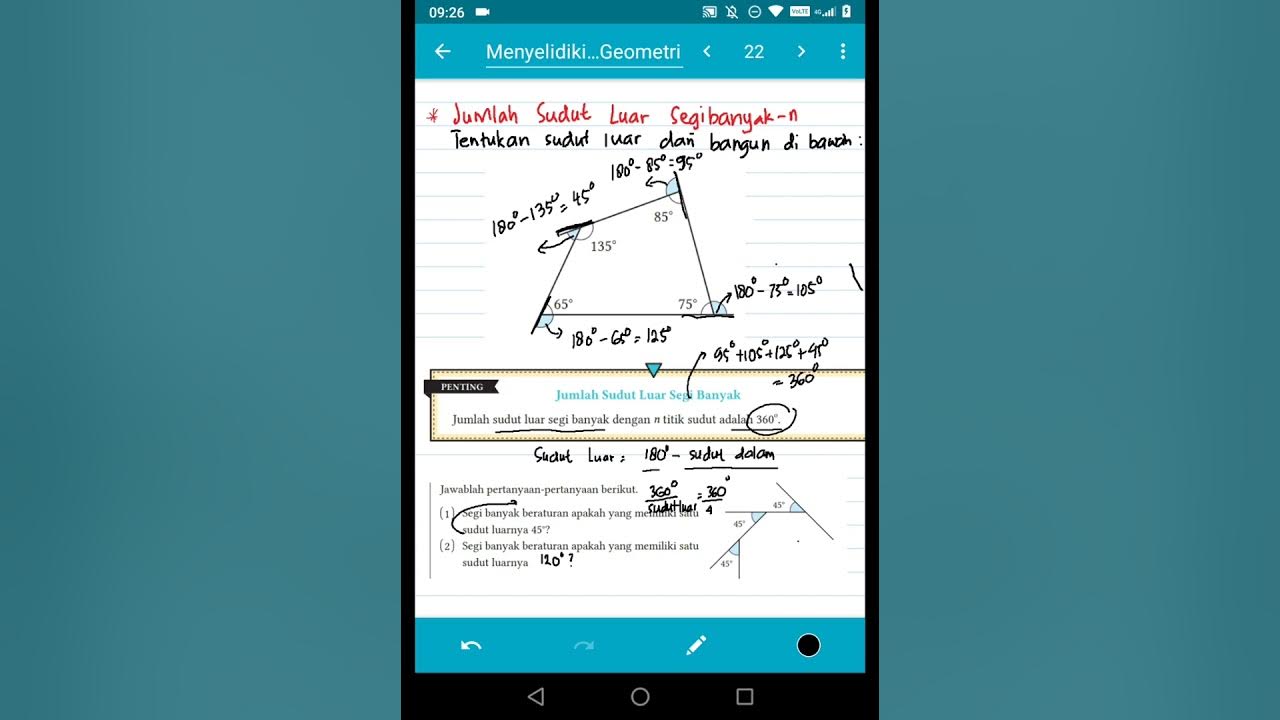2 Missing Angles in a Polygon
Summary
TLDRIn this video, the presenter demonstrates how to calculate a missing angle in a polygon. Using the formula (n-2) * 180, they determine the total degrees in a five-sided pentagon to be 540°. By subtracting the known angles (112°, 130°, 96°, and 105°) from the total, the missing angle is calculated to be 97°. The video emphasizes checking the work by adding all angles to ensure they sum to 540°.
Takeaways
- 📝 The video demonstrates how to find a missing angle in a polygon.
- 📏 It begins by recalling the formula (n - 2) * 180 to determine the total degrees in a polygon.
- 🔺 For this example, a pentagon (5-sided shape) is used.
- 🔢 The calculation starts with n = 5, leading to (5 - 2) * 180 = 540°.
- 📐 This means the total internal angles of the pentagon add up to 540°.
- ➖ To find the missing angle, subtract the known angles from 540°.
- ✏️ The known angles are: 112°, 130°, 96°, and 105°.
- 🔍 Subtracting these from 540° leaves the missing angle, y, which is calculated to be 97°.
- ✅ The result is verified by ensuring the sum of all angles equals 540°.
- 🔚 The method is summarized: use the total degree formula, subtract known angles, and check the sum for accuracy.
Q & A
What is the formula used to find the total sum of interior angles in a polygon?
-The formula is (n - 2) * 180, where n is the number of sides in the polygon.
How many sides does the polygon in the example have?
-The polygon in the example is a pentagon, which has 5 sides.
How do you calculate the total sum of the interior angles for a pentagon?
-For a pentagon, n is 5. Using the formula (n - 2) * 180, we get (5 - 2) * 180 = 3 * 180 = 540 degrees.
What is the first step in finding the missing angle in the polygon?
-The first step is to calculate the total sum of the interior angles of the polygon using the formula.
How do you determine the missing angle once you have the total sum of the interior angles?
-Subtract the sum of the known angles from the total sum of the interior angles.
What are the known angles in the example provided?
-The known angles are 112 degrees, 130 degrees, 96 degrees, and 105 degrees.
How do you find the value of the missing angle?
-Subtract the sum of the known angles from 540 degrees: 540 - (112 + 130 + 96 + 105).
What is the value of the missing angle in the example?
-The missing angle is 97 degrees.
How can you verify the correctness of the calculated missing angle?
-Add the missing angle to the known angles and ensure the total is 540 degrees.
What should you do if the sum of the angles does not equal the total calculated sum of interior angles?
-If the sum is incorrect, recheck your calculations for any errors in the steps.
Outlines

This section is available to paid users only. Please upgrade to access this part.
Upgrade NowMindmap

This section is available to paid users only. Please upgrade to access this part.
Upgrade NowKeywords

This section is available to paid users only. Please upgrade to access this part.
Upgrade NowHighlights

This section is available to paid users only. Please upgrade to access this part.
Upgrade NowTranscripts

This section is available to paid users only. Please upgrade to access this part.
Upgrade Now5.0 / 5 (0 votes)





